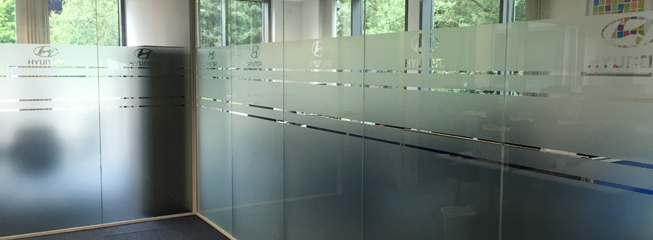
-
Chesham (Head Office)
-
01494 794477
- chesham@windowfilm.co.uk
-
London
-
020 3326 1718
- london@windowfilm.co.uk
-
Birmingham
-
0121 270 2250
- birmingham@windowfilm.co.uk

The job involved the recreation of the famous Hyundai logo and an application to a number of glass partitions throughout the car company’s Buckinghamshire premises. You’ve probably walked past countless similar examples today alone, but what exactly is manifestation and why is it necessary?
When is manifestation required and why?
Markings are required by law if your premises feature any full length glazing. The most common examples are partitions and glass doors, and manifestation is necessary to ensure that such large expanses of glass are easily visible – preventing people from walking into the glass and potentially sustaining an injury.

What are the requirements?
Building regulations state that the appropriate requirements (M1 or M2) will be satisfied if the following criteria are met:
a) They are clearly defined with glass manifestation on the glass at two levels; between 850mm and 1000mm and between 1400mm and 1600mm above the floor, contrasting visually with the background seen through the glass (both inside and out) in all lighting conditions.
b) Manifestation takes the form of logo or sign at least 150mm high (repeated if on a glazed screen), or a decorative feature such as broken lines or continuous bands, at least 50mm high.
What are the possibilities?
As long as the criteria listed above are met, there are very few limitations on how manifestation should appear. As long as the chosen marking provides a suitable contrast between it and the background, is in the correct location and of the appropriate minimum size, it is an opportunity to be as creative – or as straightforward – as you choose. The Window Film Company can provide and install standard patterns such as dots, squares and lines, usually created from Frostbrite frosted film.
It’s also possible to create fully customised designs by cutting logos or designs from the film, or printing in full colour onto its surface. In short, the opportunities are virtually limitless!

What did Hyundai choose?
This project saw the recreation of the famous Hyundai logo, created by computer cutting the design out of frosted window film. In addition, extra pieces of Frostbrite film were applied under the logo which served to add an extra element of style, while also delivering privacy for colleagues and visitors the other side of the glass.
In using Frostbrite frosted window film, the glass took on the appearance of acid-etched or sandblasted glass, blocking vision from both sides of the glazing while also giving a contemporary and stylish aesthetic finish.
For more details on when manifestation is required and for information on how The Window Film Company can help to make sure your obligations are met, please contact a member of the team on 01494 794477 or email info@windowfilm.co.uk.
* Front Door Window Film
* How To Frost Windows
* Stick On Window Films
* High Quality Window Films
* Window Tinting for the Home
* Conservatory Roof Films
* Window Protection Films
* Window Foils & Glass Films
* Window Film to Block Sunlight
* High Performance Window Films
* Window Film to Block the View
* Translucent Window Films
* Bathroom Window Film
* Kitchen Window Film
* Obscure Glass Window Film